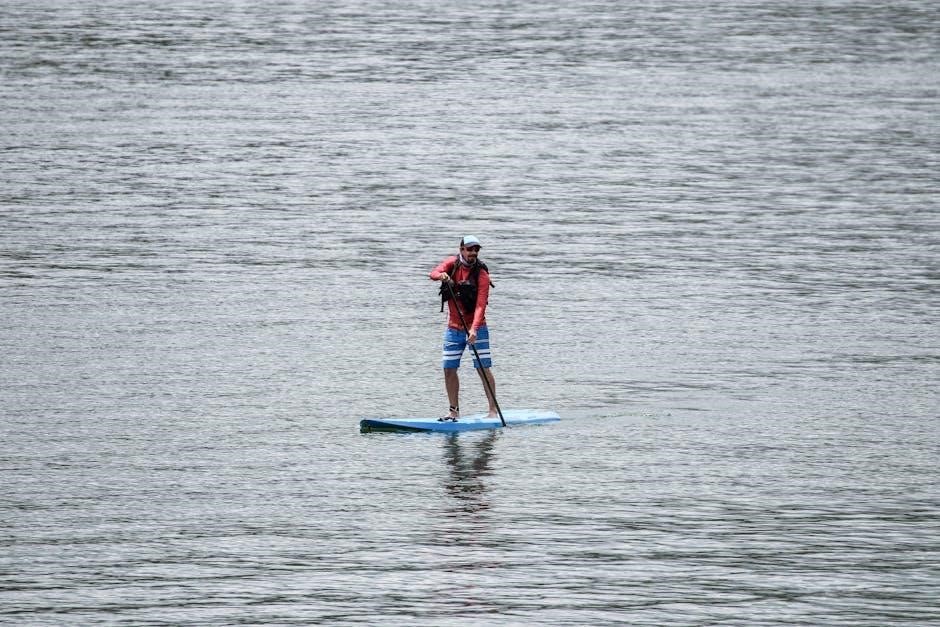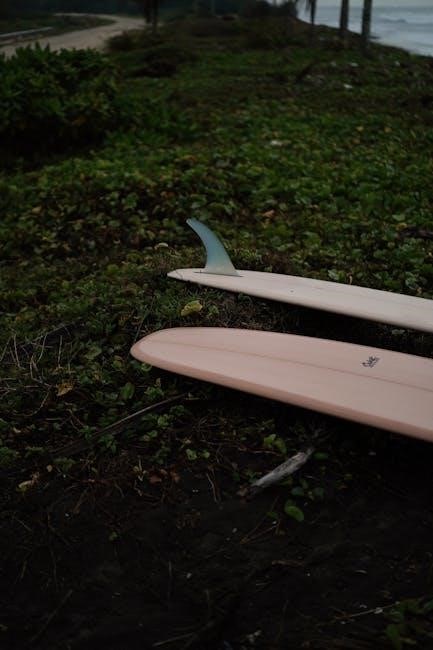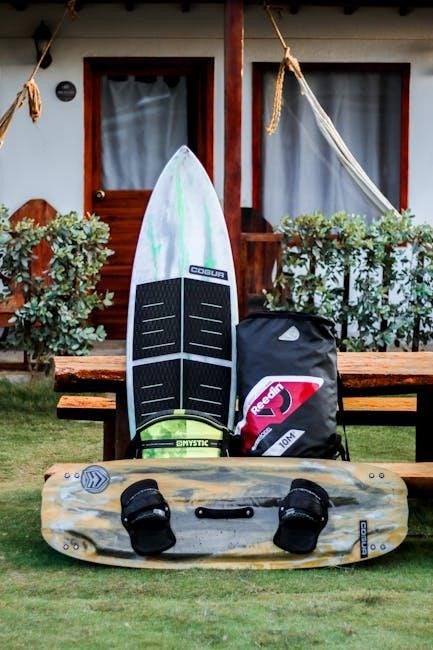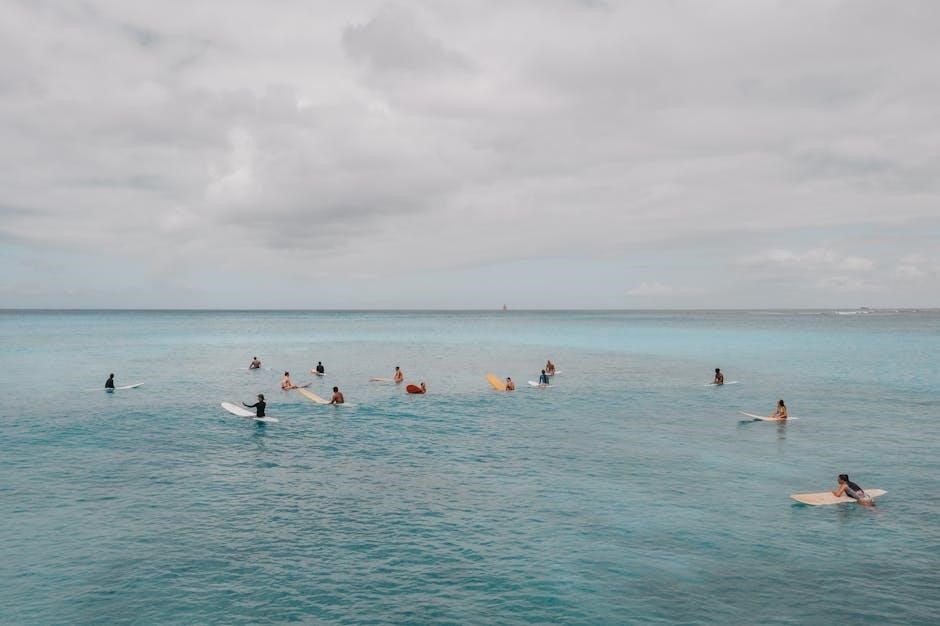Choosing the right paddle board size is crucial for performance‚ comfort‚ and stability. This guide helps you understand key considerations and offers tips for selecting the perfect SUP.
1.1 Key Considerations for Choosing the Right Paddle Board Size
When selecting a paddle board‚ consider your height‚ weight‚ skill level‚ and intended use. Longer boards offer better tracking for touring‚ while shorter boards are ideal for maneuverability. Wider boards provide stability‚ making them great for beginners or fitness activities. Thickness affects buoyancy and rigidity‚ with 4-6 inches being standard. Your paddling style and the water conditions you’ll encounter also play a role. Balancing these factors ensures optimal performance and comfort‚ helping you choose a board that meets your needs and enhances your paddling experience.

Factors Influencing Paddle Board Size
Factors influencing paddle board size include intended activities‚ stability needs‚ volume‚ and the rider’s skill level and weight. Each aspect impacts the ideal board dimensions.
2.1 Activities and Usage (Recreational‚ Touring‚ Racing‚ etc.)
Different activities require specific paddle board sizes. Recreational users benefit from stable‚ all-round boards (10-11 feet)‚ while touring demands longer‚ narrower boards (12-14 feet) for efficiency. Racers prefer lightweight‚ streamlined options for speed. The intended use significantly impacts the ideal dimensions‚ ensuring optimal performance and enjoyment. Choosing the right size based on activity enhances stability‚ maneuverability‚ and overall experience. Always consider your primary use to select the most suitable board size.
2.2 Skill Level and Experience (Beginner‚ Intermediate‚ Advanced)
Beginners benefit from wider‚ more stable boards (32-34 inches) for better balance. Intermediate paddlers can handle slightly narrower boards for improved efficiency. Advanced users often prefer narrower‚ streamlined designs for speed and maneuverability. Skill level directly influences the ideal board dimensions‚ as stability needs decrease with experience. Volume and capacity also play a role‚ ensuring the board supports the rider’s weight. Matching the board size to skill level enhances performance and comfort‚ making the paddling experience more enjoyable and effective.
2.3 Rider Weight and Height
Rider weight and height significantly impact paddle board size selection. Heavier paddlers require boards with higher volume for stability and buoyancy‚ while taller individuals may need longer boards for comfort. Weight capacity is a critical factor‚ as exceeding it can compromise performance. Generally‚ boards are sized to accommodate a range of weights‚ ensuring optimal stability. Matching the board’s volume to the rider’s weight ensures proper flotation and maneuverability. Height influences paddle length but also affects how the rider interacts with the board’s dimensions. Proper sizing based on weight and height enhances overall paddling efficiency and enjoyment.

Types of Paddle Boards and Their Size Ranges
Explore various paddle board types‚ each designed for specific activities‚ with size ranges catering to different needs‚ from stability to speed and versatility in water conditions.
3.1 All-Round Boards (10-11 feet‚ 32-34 inches wide)
All-round paddle boards‚ measuring 10-11 feet in length and 32-34 inches in width‚ are ideal for versatility and stability. They are perfect for general use‚ offering a balance between maneuverability and tracking‚ making them suitable for calm waters and light waves. These boards are great for beginners and experienced paddlers alike‚ providing a stable platform for fitness‚ recreation‚ and exploring various water conditions. Their moderate size ensures easy handling and portability‚ while their width enhances stability‚ making them a popular choice for everyday use.
3.2 Touring Boards (12-14 feet‚ narrower width)
Touring paddle boards‚ ranging from 12-14 feet in length with a narrower width‚ are designed for long-distance paddling and efficiency. Their streamlined shape reduces drag‚ allowing for smoother gliding across the water. These boards are ideal for experienced paddlers seeking to cover greater distances or explore open waters. The narrower width enhances speed and tracking‚ making them suitable for adventure and exploration. While they may offer less stability than all-round boards‚ their performance in speed and endurance makes them a top choice for serious enthusiasts.

3.3 Inflatable vs. Hard Boards (Thickness: 4-6 inches)
Inflatable paddle boards‚ typically 4-6 inches thick‚ offer portability and durability‚ making them perfect for traveling or storage. They are lightweight and soft‚ providing a cushioned surface for added comfort. Hard boards‚ while heavier‚ deliver superior performance in speed and stability. Inflatables are ideal for beginners or those needing convenience‚ while hard boards suit experienced paddlers seeking optimal performance. Both options cater to different needs‚ ensuring a versatile choice for various paddling preferences and conditions;

Volume and Capacity
Volume and capacity are vital for a paddle board’s buoyancy and stability. Higher volume supports more weight‚ ensuring better performance for riders of varying sizes and skill levels.
4.1 Understanding Board Volume and Its Importance
Board volume‚ measured in liters‚ determines buoyancy and stability. Higher volume boards float better‚ supporting heavier riders and improving performance. It ensures the board stays stable‚ even when loaded with gear or multiple riders. Proper volume matches rider weight and activity needs‚ enhancing paddling efficiency. A board with insufficient volume may feel unstable or difficult to maneuver‚ especially for beginners. Thus‚ understanding volume is key to selecting a suitable paddle board for optimal performance and comfort.
4.2 Weight Capacity and Stability
Weight capacity directly impacts a paddle board’s stability and performance. Exceeding the recommended weight can compromise stability‚ making the board less responsive and more difficult to maneuver. Riders should consider their weight‚ along with any gear or passengers‚ to ensure the board remains within its capacity. Proper weight distribution ensures optimal buoyancy‚ preventing the board from sitting too low in the water. This balance is crucial for beginners‚ as it enhances comfort and control. Always prioritize a board that meets your weight needs for a safe and enjoyable paddling experience.

Length‚ Width‚ and Thickness

Length‚ width‚ and thickness are key factors in paddle board performance. Longer boards glide better‚ wider boards offer stability‚ and thicker boards provide buoyancy and stiffness.
5.1 Length (10-14 feet)
Paddle board length ranges from 10 to 14 feet‚ impacting stability‚ speed‚ and maneuverability. Shorter boards (10-11 feet) are great for beginners and surfing‚ offering easy handling. Medium lengths (12 feet) balance stability and glide‚ ideal for touring. Longer boards (13-14 feet) are built for speed and efficiency‚ best for experienced paddlers. The right length ensures optimal performance for your specific activity and skill level‚ making it essential to consider when selecting a board.
5.2 Width (32-34 inches)
Paddle board width significantly impacts stability and maneuverability. Boards measuring 32-34 inches wide are the most common‚ offering a balance between stability and performance. Wider boards (closer to 34 inches) provide greater stability‚ making them ideal for beginners or those prioritizing comfort. Narrower widths (around 32 inches) enhance speed and efficiency‚ suited for experienced paddlers or touring. The width also affects tracking and glide‚ ensuring a smooth experience on the water. Choosing the right width ensures optimal performance for your paddling style and goals.
5.3 Thickness (4-6 inches)
Paddle board thickness ranges from 4 to 6 inches‚ impacting buoyancy‚ stability‚ and performance. Thicker boards (5-6 inches) offer greater buoyancy and stiffness‚ ideal for heavier riders or those seeking enhanced stability. Thinner boards (4 inches) are lighter and more maneuverable‚ suitable for smaller riders or advanced paddlers. The thickness also affects the board’s rigidity and how it glides through the water. Balancing thickness with length and width ensures optimal performance and comfort for your paddling needs.
Selecting the right paddle board size requires balancing activity type‚ stability needs‚ and rider height. Prioritize these factors to ensure a fun and efficient paddling experience.
6.1 Final Tips for Selecting the Perfect Paddle Board Size
When choosing a paddle board‚ consider your height‚ weight‚ and intended use. Wider boards offer stability‚ while narrower ones enhance speed. Opt for 10-11 feet for all-round use or 12-14 feet for touring. Thickness should be 4-6 inches for buoyancy. Test different sizes if possible and prioritize volume for your weight to ensure stability. Remember‚ the right size enhances performance and comfort‚ making your paddling experience enjoyable and effective.
